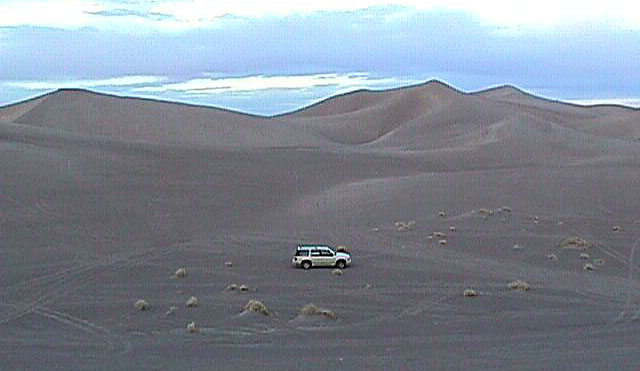The following information is from the Meteoritical Bulletin web site:
http://meteoriticalsociety.org/simple_template.cfm?code=pub_bulletin
Gold Basin (Found 1995) - L4, S3, W3 - [Or is it L4-L6, S3-S5, W1-W5??]
White Elephant - L4, S3, W3 - [indistinguishable from Gold Basin]
35º53.4'N, 114º12.2'W -
Mohave County, Arizona, USA -
Found 1997 January 05
by John Blennert; recognized by A. T. Jull after C14 testing.
King Tut - Ordinary chondrite (L5 S3 W2) -
35º55.4'N, 114º6.1'W -
Mohave County, Arizona, USA -
Found 1997 March 06
A 19.51 g stone was found by John Blennert while he was searching for gold with a metal detector. Classification and mineralogy (D. Kring, UAz): olivine, Fa24.7±0.5; pyroxene, Fs20.4±0.1 Wo1.6±0.1; kamacite contains 0.7±0.2 wt% Co; shock stage, S3; weathering grade, W2; probably not paired with Gold Basin based on a terrestrial age measurement of 11.4±1.8 ka (T. Jull, UAz). Specimens: type specimen, 0.6 g plus 6 thin sections, UAz; main mass with finder.
Hualapai Wash 021 - Ordinary chondrite (H4 S1 W2) -
35º53.37'N, 114º11.52'W -
Mohave County, Arizona, USA -
Found 1997 March 11
A 20.5 g stone was found by John Blennert while he was searching for meteorites with a metal detector. Classification and mineralogy (D. Kring, UAz): olivine, Fa19; shock stage, S1; weathering grade, W2; Specimens: type specimen, 6.6 g plus thin sections, UAz; main mass with UAz.
Temple Bar - Carbonaceous chondrite (CR) -
35º55'N, 114º26'W -
Mohave County, Arizona, USA -
Found 1998 autumn
A 106 g stone was found by a prospector near the road, 7 miles south of Temple Bar. Classification and mineralogy (M. Killgore, SWML):
chondrules range from 0.4 to 4 mm, and comprise .50 vol%; metal occurs mostly inside chondrules; brownish-yellow phyllosilicates present; olivine, Fa2.3 , range Fa0.7.4.3 , n = 10; probably little shocked; weathering grade, W5. Specimens: main mass, SWML; 23 g, ASU.
Golden Rule - Ordinary chondrite (L5) -
35º52.4'N, 114º12'W -
Mohave County, Arizona, USA -
Found 1999 February 16
A 797.6 g stone was found by Ingrid Monrad while she was searching for pieces of the Gold Basin meteorite using a metal detector. Classification and mineralogy (D.Kring, UAz): olivine, Fa24.1±0.5; pyroxene, Fs20.6±0.8Wo2.0±0.4; shock stage, S3; weathering grade, W1. Specimens: type specimen, 22 g plus two thin sections, UAz; main mass with finder.
White Hills - Mesosiderite -
35º51.4' N, 114º13.4' W -
Mohave County, Arizona, USA -
Found 1999 December 12
An 11.7 g meteorite was found by Jim Kriegh while he was surveying the Gold Basin strewnfield with a metal detector. Classification and mineralogy (I. Daubar and D. Kring, UAz): metal, 37 vol%, is dominantly kamacite (6.0 wt% Ni), with some taenite (39.47 wt%Ni); silicate portion, 63 vol%, is dominantly pigeonite (Fs33.4 Wo2.8 ) with augite exsolution (Fs42.7 Wo42.3 ) and plagioclase (Ab89.5 Or0.4 ), with minor olivine (Fo76.91 ), tridymite, phosphate, chromite, troilite,
schreibersite, and rutile; shock stage estimated at S2 from pyroxene; weathering grade, W1. Specimens: main mass with finder; type specimen, .3 g plus two thin sections, UAz
Golden Mile - Ordinary chondrite (H4 S1 W1) -
35º53.4'N, 114º10'W -
Mohave County, Arizona, USA -
Found 2000 October 31
A 378.8 g stone was found by Ingrid Monrad while she was searching for pieces of the Gold Basin meteorite using a metal detector. Classification and mineralogy (D.Kring, UAz): olivine, Fa18±3; pyroxene, Fs15±5.2?; shock stage, S1; weathering grade, W1. Specimens: type specimen, 30 g plus thin sections, UAz; main mass with finder.
Hualapai Wash - (L6, S4, W3) - [ v "Gold Basin (L4-6)"]
35º51.8'N, 114º11.6'W -
Mohave County, Arizona, USA -
Found 2000 November 18
A 240.5 g stone was found by Donald O'Keeffe while he was searching for meteorites with a metal detector. Classification and mineralogy (A. Rubin, UCLA): olivine, Fa24.6; shock stage, S4; weathering grade, W3; Specimens: type specimen, 20.5 g plus thin sections, UCLA; main mass with finder.
Hualapai Wash 020 - Ordinary chondrite (H5 S2 W2) -
35º50.3'N, 114º 9.97'W -
Mohave County, Arizona, USA -
Found 2003 January 02
A 60.9 g stone was found by an acquaintance of John Adams while he was searching for meteorites with a metal detector. Classification and mineralogy (D. Kring, UAz): olivine, Fa18.7; pyroxene, Fs16.8; shock stage, S2; weathering grade, W2; Specimens: type specimen, 14.25 g plus thin sections, UAz; main mass with John Adams.
Bluebird - Ordinary chondrite (L6 S4 W2) -
35º52.05'N, 114º 11.5'W -
Mohave County, Arizona, USA -
Found 2002 January 15
A 3.65 kg stone was found by John Wolfe while he was searching for meteorites with a metal detector. Classification and mineralogy (A. Rubin, UCLA): olivine, Fa24.5; shock stage, S4; weathering grade, W2; Specimens: type specimen, 26.4 g plus thin sections, UCLA; main mass with Verish.
 TO COME
TO COME
